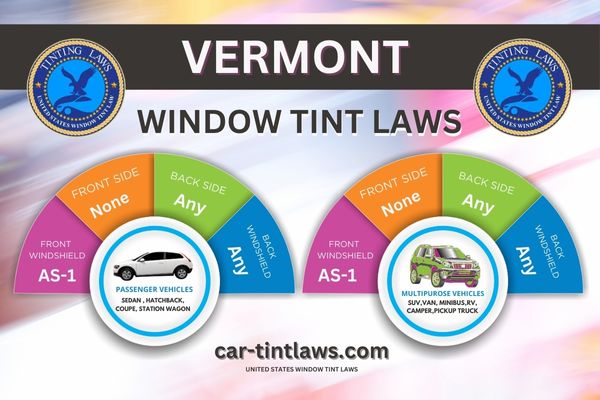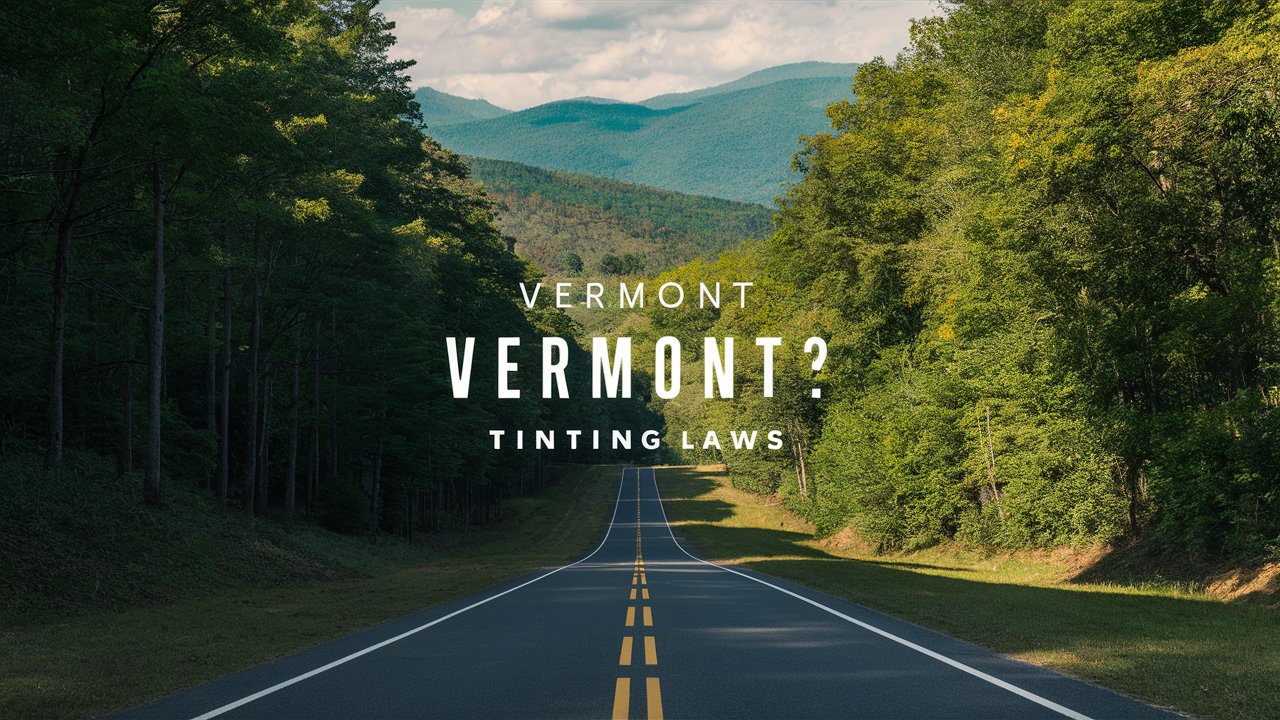Imagine you’re driving through Vermont with window tints that seem perfectly fine, only to get pulled over and fined because they don’t comply with state laws.
Vermont’s window tinting regulations are quite specific, covering everything from the darkness levels to reflectivity and even color restrictions.
Did you know that sedans and SUVs/vans have different requirements? And if you have a medical condition, you might qualify for an exemption with proper documentation.
Understanding these rules not only keeps you compliant but also guarantees road safety. Curious about how these laws could affect you? Let’s explore the details.
Window Tint Darkness in Vermont
When considering window tint darkness for your vehicle in Vermont, understanding that the regulations vary between sedans, SUVs, and vans is important.
For sedans, the front side windows must allow more light through compared to the rear windows, which can have a darker tint. In contrast, SUVs and vans have more lenient rules, allowing darker tints on both the rear windows and rear windshield.
Tint darkness for sedans:
- Windshield: Non-reflective tint is allowed on the top 6 inches of the windshield.
- Front Side windows: Must remain clear.
- Back Side windows: No restrictions on darkness level.
- Rear Window: No restrictions on darkness level.
Tint darkness for SUV and Vans:
- Windshield: Non-reflective tint is allowed on the top portion of the windshield, above the AS-1 line.
- Front Side windows: Must allow more than 32% of light in.
- Back Side windows: Any shade can be used.
- Rear window: Any shade can be used.
Window Tint Reflection in Vermont
When it comes to window tint reflection in Vermont, you need to be aware of specific rules for sedans, SUVs, and vans. For sedans, the state prohibits metallic or mirrored tints on the front and back side windows, ensuring a minimal reflective appearance.
Similarly, SUVs and vans must adhere to these restrictions, although reflective tint can still help reduce glare and heat inside the vehicle.
Tint reflection for sedans:
- Front Side windows: Reflectivity must not exceed 20%.
- Back Side windows: Reflectivity must not exceed 20%.
Tint reflection for SUV and vans:
- Front Side windows: Must not have a metallic or mirrored appearance.
- Back Side windows: Must not have a metallic or mirrored appearance.
Other Vermont window tint rules and regulations
- Side Mirrors: No restrictions.
- Restricted Colors: In Vermont, all tint colors are permitted.
- Certificates: Manufacturers of film need to certify the film they sell in the state. Ask your dealer if they are using certified film.
- Stickers: There is no requirement for a specific sticker to identify legal window tinting in Vermont.
- Medical Exceptions: In Vermont, medical exemptions for special window tint are not allowed under any circumstances.
- Penalties: Violating tint regulations in Vermont could result in fines, so it’s important to adhere to the rules to avoid unnecessary costs.

Medical Exemptions for Window Tint Rules in Vermont
For those with specific medical conditions, you can acquire a window tint exemption in Vermont with the proper documentation from a licensed medical professional.
If you suffer from conditions such as Photophobia, Lupus, Albinism, Melanoma, or specific eye disorders, you may qualify for a window tint medical exemption.
Vermont laws require you to submit a medical exemption form, which must be filled out by your healthcare provider, detailing your condition and the necessity for the exemption.
These medical exemptions are granted on a case-by-case basis, meaning not all medical conditions will automatically qualify.
It’s important to understand that having the appropriate documentation does not guarantee approval, as each application is reviewed individually.
Once you obtain the exemption, remember that it’s not a one-time process; you must renew your exemption permit regularly to stay compliant with Vermont laws.
This guarantees that your condition still justifies the need for tinted windows and maintains legal compliance.
While Vermont doesn’t regulate window tint color or reflectiveness, or require certification for window tinting, medical exemptions are an exception and must adhere to these specific requirements.
Stay updated with these regulations to ensure your window tint remains within legal limits.
Vermont DMV – Application for window tint medical exemption permit (.pdf file)
Vermont Window Tint Ticket Cost
Getting a ticket for illegal window tint in Vermont can cost you anywhere from $50 to $250.
If you’re not mindful of the State of Vermont’s window tinting regulations, you might find yourself facing these fines.
Law enforcement officers can issue citations during traffic stops if they determine that your window tint doesn’t comply with state laws.
Additionally, there may be extra court costs and fees added to the initial fine, further increasing the financial burden.
To avoid these penalties, it’s essential to understand and follow Vermont’s specific rules regarding tint darkness and placement.
This means ensuring that your vehicle windows meet the legal standards set by the state.
For instance, the front side windows must allow more light to pass through compared to the rear windows.
However, there are medical exemptions available for those who have a legitimate need for darker window tints due to health conditions.
If you qualify for a medical exemption, make sure to have the proper documentation readily accessible to present to law enforcement if questioned.
Vermont DMV Contact Information
To get accurate information and assistance about window tinting laws and medical exemptions, you’ll need to reach out to the Vermont DMV.
They offer various ways to contact them, including office locations and hours, phone and email contacts, and online services.
Make sure you have all necessary documentation ready for a smooth process.
Office Locations & Hours
With numerous DMV offices spread across Vermont, you’ll find convenient access to essential services like vehicle registration and driver’s license issuance.
If you’re dealing with window tint regulations, such as guaranteeing your front windows comply or seeking a medical exemption, the DMV is your go-to place for guidance and processing.
The Vermont DMV locations are scattered statewide, making it easy for you to handle your vehicle-related needs.
These offices typically follow a standard schedule, though hours may vary slightly depending on the location.
You can expect services like vehicle registration, driver’s license issuance, and title transfers to be readily available.
Some DMV offices have designated days or specific times for particular services or appointments, so it’s a good idea to check the schedule before you plan your visit.
This ensures you can effectively manage your time and get the assistance you need without unnecessary delays.
For the most accurate and up-to-date information on office hours and locations, visiting the official Vermont DMV website is recommended.
Here, you’ll find all necessary details to help you navigate your DMV-related tasks smoothly.
Phone & Email Contacts
For any questions or concerns about Vermont’s window tinting laws, you can contact the DMV directly at 802-828-2000 or via email at dmv.vermont.gov/contact.
Whether you’re seeking clarification on window tint darkness regulations or inquiring about medical exemption permits, the Vermont DMV is available to help you.
If you have a medical condition that requires a darker tint, the DMV provides detailed information on how to obtain a medical exemption permit.
This can be particularly important if your vehicle’s window tint darkness exceeds standard legal limits.
By contacting them, you can make sure you have all the necessary documentation and understand the process involved.
Additionally, understanding and complying with Vermont’s window tinting laws is essential, as non-compliance can lead to interactions with the Police Department.
The DMV’s resources and support are available to help you stay within legal guidelines and avoid any potential issues.
Don’t hesitate to reach out to the DMV for any assistance you might need.
Their phone and email contacts are there to support you in navigating the intricacies of window tint regulations, ensuring you feel informed and connected with the community.
Online Services Available
Exploring Vermont DMV’s online services can simplify your process of managing window tinting regulations and permits.
By utilizing these online resources, you can apply for a medical exemption permit for window tinting, renew existing permits, and access all necessary forms without leaving your home.
This user-friendly platform guarantees that you’re able to submit and process medical exemption forms efficiently.
For those who need a medical exemption, the DMV’s online services provide detailed information on qualifying medical conditions, required documentation, and guidelines for maintaining exemption status.
This makes it easier to understand whether you qualify and what steps you need to take.
The online services are designed to streamline the process, saving you time and effort.
Accessing the Vermont DMV’s online services is straightforward. Simply visit their website and navigate to the window tint section.
There, you can find all the resources you need, including application forms and renewal options.
By taking advantage of these online services, you guarantee that your vehicle complies with Vermont’s window tint laws while meeting any medical needs you may have.
This efficient approach helps keep you informed and compliant with minimal hassle.
References
Vermont Statutes Title 23, Chapter 13, Subchapter 1, section 1125: Obstructing windshields
Frequently Asked Questions
Can You Tint Your Headlights in Vermont?
No, you can’t tint your headlights in Vermont. Headlight tinting is prohibited due to strict tint regulations. It’s all about vehicle safety.
Following these guidelines guarantees everyone’s safety on the road and keeps you compliant.
What State Has the Darkest Tint Law?
In the shadowy domain of tint laws, Alaska stands out with the darkest tint allowed.
When comparing states, their unique climate shapes their tint darkness limits and enforcement policies, creating a sense of belonging for residents.
What Is the Legal Tint in New Hampshire?
In New Hampshire, the legal limits for window tint vary by window type. Enforcement issues focus on safety concerns, ensuring visibility.
You’ll need dual side mirrors if the back window’s tinted. Stay compliant to avoid penalties.
Conclusion
Understanding Vermont’s window tinting laws is essential for ensuring road safety and compliance.
Have you considered how these regulations impact your vehicle’s tinting? Adhering to guidelines for darkness levels, reflectivity, and color restrictions, whether for sedans or SUVs/vans, is vital.
Medical exemptions are available with proper documentation. Non-compliance can lead to fines and penalties, so it’s crucial to stay informed.
For more details, contact the Vermont DMV or refer to the provided tint law references.
